
Wollongong is a city located in the Illawarra region of New South Wales, Australia. The name is believed to originate from the Dharawal language, meaning either 'five islands/clouds', 'ground near water' or 'sound of the sea'. Wollongong lies on the narrow coastal strip between the Illawarra Escarpment and the Pacific Ocean, 85 kilometres south of Sydney. Wollongong had an estimated urban population of 302,739 at June 2018, making it the third-largest city in New South Wales after Sydney and Newcastle and the tenth-largest city in Australia by population. The city's current Lord Mayor is Tania Brown who was elected in 2024.

Bulli is a northern suburb of Wollongong situated on the south coast of New South Wales, Australia.

Mount Keira is a suburb and mountain in the Illawarra region of New South Wales, Australia.

Grevillea, commonly known as spider flowers, is a genus of about 360 species of evergreen flowering plants in the family Proteaceae. Plants in the genus Grevillea are shrubs, rarely trees, with the leaves arranged alternately along the branches, the flowers zygomorphic, arranged in racemes at the ends of branchlets, and the fruit a follicle that splits down one side only, releasing one or two seeds.

Albion Park railway station is a heritage-listed railway station located on the South Coast railway line on the Princes Highway in Albion Park Rail, New South Wales, Australia. The station was designed by New South Wales Government Railways and built during 1887 by William Monie & Company, with the single line railway line built by David Proudfoot and Thomas Logan. The complex is also known as the Albion Park Railway Station Group. The property was added to the New South Wales State Heritage Register on 2 April 1999. The station is located close to Shellharbour Airport.

The Illawarra escarpment, or officially the Illawarra Range, is the fold-created cliffs and plateau-eroded outcrop mountain range west of the Illawarra coastal plain south of Sydney, in the state of New South Wales, Australia. The range encloses the Illawarra region which stretches from Stanwell Park in the north to Kiama, Gerringong and the Shoalhaven River in the south.

Banksia ericifolia, the heath-leaved banksia, or lantern banksia, is a species of woody shrub of the family Proteaceae native to Australia. It grows in two separate regions of Central and Northern New South Wales east of the Great Dividing Range. Well known for its orange or red autumn inflorescences, which contrast with its green fine-leaved heath-like foliage, it is a medium to large shrub that can reach 6 m (20 ft) high and wide, though is usually half that size. In exposed heathlands and coastal areas, it is more often 1–2 m (3.3–6.6 ft).

Grevillea aquifolium is a shrubby or scrambling plant endemic to South Australia and Victoria. Common names include holly grevillea, prickly grevillea or variable prickly grevillea. It occurs naturally in woodland, open forest and heathland.
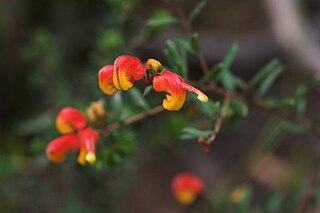
Grevillea alpina is a species of flowering plant in the family Proteaceae. It has several common names, including mountain grevillea, alpine grevillea, and cat's claws. It is endemic to Australia. It is not limited to alpine environments, and in fact is less common at high elevation than low. The species is variable in appearance, with five general forms described: small-flowered, Grampians, Northern Victorian, Goldfields, and Southern Hills forms. It is found in dry forests and woodlands across Victoria and into southern New South Wales. Some forms of the plant are low to the ground, and some become a spreading shrub. The flowers come in many colours, from white to green to shades of red and pink, or a pattern of several colours. The curled flowers are 1 to 3 centimetres in length. It is attractive to nectar-feeding insects and birds.

Bellambi is a suburb of Wollongong in the Illawarra region of New South Wales, Australia. It has a railway station on the NSW TrainLink South Coast Line.
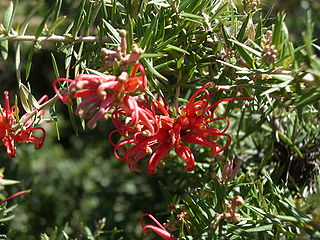
Grevillea juniperina, commonly known as juniper- or juniper-leaf grevillea or prickly spider-flower, is a plant of the family Proteaceae native to eastern New South Wales and southeastern Queensland in Australia. Scottish botanist Robert Brown described the species in 1810, and seven subspecies are recognised. One subspecies, G. j. juniperina, is restricted to Western Sydney and environs and is threatened by loss of habitat and housing development.
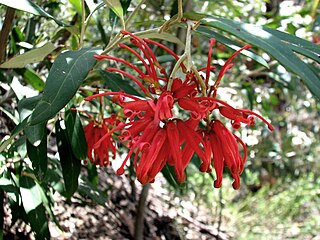
Grevillea victoriae, also known as royal grevillea or mountain grevillea, is a species of flowering plant in the family Proteaceae and is endemic to mountainous regions of south-eastern continental Australia. It is an erect to spreading shrub with elliptic to lance-shaped leaves, and pendulous clusters of red to orange flowers.
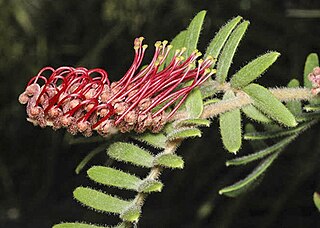
Grevillea caleyi, also known as Caley's grevillea, is a critically endangered species of flowering plant in the family Proteaceae, and is endemic to a restricted area around the Terrey Hills and Belrose area in New South Wales. It is an open, spreading shrub, growing up to 4 m (13 ft) tall with deeply divided leaves with linear lobes, and fawn flowers with a maroon to red style.

Grevillea exul, also known as Common toothbrush is a species of flowering plant in the family Proteaceae, endemic to New Caledonia. It is a shrub or tree with white flowers which grows up to 4–10 metres (13–33 ft) tall. Like all other grevillea species of New Caledonia, it is a manganese accumulator.
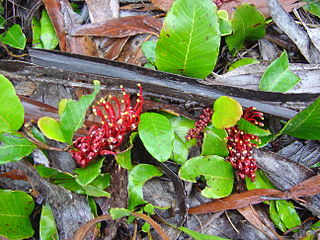
Grevillea laurifolia, commonly known as laurel-leaf grevillea, is a species of flowering plant in the family Proteaceae and is endemic to New South Wales. It is a prostrate, trailing shrub with egg-shaped, heart-shaped or round leaves, and clusters of reddish to deep maroon flowers.

Grevillea lanigera 'Mt Tamboritha' is a cultivar of the genus Grevillea, planted widely in Australia and other countries for its ornamental foliage and flowers. It is the most popular form of Grevillea lanigera in cultivation. It is also known by the names 'Mt Tamboritha form', 'Compacta', 'Prostrate', 'Prostrate Form' or the misnomer 'Mt Tambourine'.

Banksia vincentia is a shrub that grows in a small location in southern New South Wales. It belongs to the Banksia spinulosa species complex and has affinities to Banksia neoanglica, found several hundred kilometres to the north.

Grevillea raybrownii is a flowering shrub in the family Proteaceae and is endemic to New South Wales. It has divided, pointed leaves and dense clusters of flowers usually at the end of branches.





















